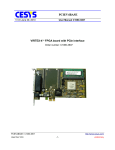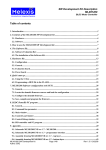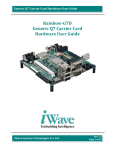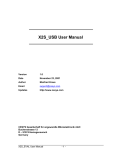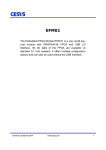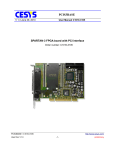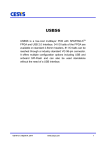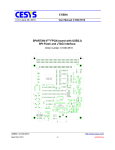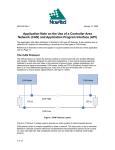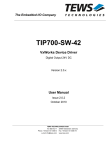Download USB3FPGA
Transcript
USB3FPGA V 1.41 February, 26 2008 User Manual C 1030-2805 SPARTAN-3E FPGA board with USB 2.0 interface Order number: C 1030-2805 USB3FPGA C 1030-2805 User Manual V 1.41 www.cesys.com preliminary Copyright information Copyright © 2007 CESYS GmbH. All Rights Reserved. The information in this document is proprietary to CESYS GmbH. No part of this document may be reproduced in any form or by any means or used to make derivative work (such as translation, transformation or adaptation) without written permission from CESYS GmbH. CESYS GmbH provides this documentation without warranty, term or condition of any kind, either express or implied, including, but not limited to, express and implied warranties of merchantability, fitness for a particular purpose, and non-infringement. While the information contained herein is believed to be accurate, such information is preliminary, and no representations or warranties of accuracy or completeness are made. In no event will CESYS GmbH be liable for damages arising directly or indirectly from any use of or reliance upon the information contained in this document. CESYS GmbH will make improvements or changes in the product(s) and/or program(s) described in this documentation at any time. CESYS GmbH retains the right to make changes to this product at any time, without notice. Products may have minor variations to this publication, known as errata. CESYS GmbH assumes no liability whatsoever, including infringement of any patent or copyright, for sale and use of CESYS GmbH products. CESYS GmbH and the CESYS logo are registered trademarks. All product names are trademarks, registered trademarks, or service marks of their respective owner. ⇒ Please check www.cesys.com to get the latest version of this document. CESYS Gesellschaft für angewandte Mikroelektronik mbH Zeppelinstrasse 6a D – 91074 Herzogenaurach Germany USB3FPGA C 1030-2805 User Manual V 1.41 www.cesys.com preliminary A Overview Summary of USB3FPGA USB3FPGA can be used as a development platform for designs with Xilinx SPARTAN 3E FPGAs as well as a OEM-component for job lot production. A 96-pin VG connector allows the attachment of external hardware to the FPGA. The board is equipped with a XC3S500E-4PQ208C XILINX FPGA, a member of the Spartan 3E family. This programmable logic device receives its internal functions after it has been configured by downloading a bitstream that represents the design. The change of logic functions (reconfiguration) is possible at any time. The bistream is loaded from the PC via USB to the FPGA. The software that comes with the board permits to load new configurations anytime. Two clock oscillators supply basic clocks that can be used by the FPGA. A third clock oszillator can be populated on request. The 96-pin VG expansion connector of the USB3FPGA allows connections to I/O pins of the FPGA as well as to 3.3 V and GND. Many extensions can be attached directly without the need of an additional external power supply Feature list • • • • • • • • • • • • XILINX XC3S500E-4PQ208C FPGA CYPRESS FX2LP USB controller 2MByte FAST SRAM (1M x 16, 10ns) connected to FPGA 64 kByte SRAM connected to USB 2.0 controller (optional) USB 2.0 compliant device Selectable self-powered or bus-powered Up to three individual onboard clock oscillators Expansion port (44 IO pins + 15 INPUT pins + 22 auxiliary IO pins) 3 LEDS All FPGA Pins routed to test connectors Driver for Windows XPTM, Firmware and Benchmark-program included Sample code (C++ Source) of test-program included Minimum requirements ☑ PC with USB 2.0 interface running Windows XPTM ☑ 10 MByte free harddisk space ☑ USB3FPGA board with USB2.0 compliant cable ☑ CESYS USB 2.0 drivers USB3FPGA C 1030-2805 User Manual V 1.41 -A 1- www.cesys.com preliminary FPGA Design Tools To simulate and synthesize FPGA designs appropriate tools are needed. Xilinx offers a toolset called “ISE WebPack” free of charge on their website: http://www.xilinx.com. The ISE WebPack fully supports the XC3S500E Spartan3EFPGA. There are also other commercial tools available from Xilinx and various other vendors. Windows XP Quick-start installation guide 1. Connect USB3FPGA to one free USB2.0 port with shipped USB2.0 compliant cable. 2. Install USB3FPGA driver via Windows XPTM installation guide from included driver and utilities CD. 3. With Windows XPTM USB3FPGA device driver has to be installed twice. 4. Locate folder “bin” on shipped CD and double-click “diag.exe”. By pressing the 'Memory Test' button on the left a first device test can be started. USB3FPGA C 1030-2805 User Manual V 1.41 -A2- www.cesys.com preliminary B Hardware USB 2.0 conncetor High-Speed USB 2.0 Peripheral controller SPARTAN-3E FPGA 96-pin VG - connector 2 Mbyte Fast SRAM 1M x 16, 10ns Clock, Reset and Power Figure 1: USB3FPGA block diagram SPARTAN-3E FPGA Device System Gates CLB Rows CLB Columns Total CLBs Total Slices Distributed RAM bits Block RAM bits Dedicated Multipliers DCMs XC3S500E-4PQ208C 500k 46 34 1164 4.656 73 k 360 k 20 4 For details on SPARTAN-3ETM FPGA, please refer to data sheet at: http://www.xilinx.com/support/documentation/data_sheets/ds312.pdf USB3FPGA C 1030-2805 User Manual V 1.41 -B 1- www.cesys.com preliminary P 99 P 97 P 94 P 91 P 89 P 86 P 83 P 81 P 78 P 77 P 75 P 72 P 69 P 65 P 63 P 61 P 58 P 56 P 98 P 96 P 93 P 90 P 87 P 84 P 82 P 80 P 76 P 74 P 71 P 68 P 64 P 62 P 60 P 57 P 55 1 P 50 P 49 P 1 09 P 108 P 48 P 1 12 P 11 0 P 45 P 1 15 P 113 P 42 P 1 18 P 116 P 40 P 1 20 P 11 9 P 36 P 1 23 P 12 2 P 33 P 1 26 P 124 P 34 P 32 P 1 28 P 12 7 P 30 P 29 P 1 29 P 130 P 28 P 26 P 1 33 P 132 P 24 P 25 P 1 34 P 135 P 22 P 23 P 1 36 P 137 P 19 P 20 P 1 38 P 139 P 16 P 18 P 1 40 P 142 P 14 P 15 P 1 44 P 145 P 11 P 12 P 1 46 P 147 P8 P9 P 1 48 P 150 P5 P6 P 1 51 P 15 2 P3 P4 P 1 53 P1 P2 P 1 84 P 1 87 P 1 90 P 1 93 P 1 96 P 1 99 P 2 02 P 2 04 P 2 06 P 18 5 P 18 6 P 18 9 P 19 2 P 19 4 P 19 7 P 20 0 P 20 3 P 20 5 P 1 74 P 17 5 P 17 8 P 1 81 P 1 71 P 1 72 P 18 3 P 1 68 P 16 9 P 1 79 P 1 65 P 16 7 P 1 80 P 1 63 P 16 4 P 1 77 P 1 61 1 SRAM A B C 1 JTAG P 39 P 35 USB2.0 Controller USB2.0 P 31 1 CONFIG LED 1 LEDA PWR PWR2 P 43 P 41 J4 SPARTAN-3E FPGA P 16 2 P 15 9 P 51 P 106 P 16 0 CON1 P 54 P 1 07 P154 P 1 04 J1 P 10 1 P 1 00 RESERVED P 1 02 32 P 10 3 Connector diagram Figure 2: USB3FPGA connector diagram Attention: The Testpin numbering printed on the PCB v1.0 is not correct in the area marked above. This error has been fixed in PCB v1.1. This document is correct. USB3FPGA C 1030-2805 User Manual V 1.41 -B2- www.cesys.com preliminary Board dimensions Figure 3: USB3FPGA board dimensions Power supply The USB3FPGA can be configured to be self powered or bus powered. The default setting is “bus powered”. This means power is provided by the USB bus. If the USB3FPGA is the only device on the USB bus, most computers should allow a maximum current of about 500 mA. This may not be true for notebooks. J1 Power source select Pin 1 – 2 Self powered (External +5 Volt power supply must be attached to connector CON1) Pin 2 – 3 Bus powered (USB power supply) USB3FPGA C 1030-2805 User Manual V 1.41 -B3- www.cesys.com preliminary The option “self powered” requires an external power supply connected to CON1. Use this method if your design draws more current than your USB bus can deliver. Attention: Be careful when using the external power connector. If you apply more than 5,5 Volts or if you reverse the polarity, the board will permanently fail and may not be reparable. Directly after the USB3FPGA board is connected to the USB bus, it must not consume more then 100mA. This is the current limit (defined by the USB standard) until the software has called “SetConfiguration”. Most PC’s ignore this restriction but some USB-hubs measure the current-flow and will report a shortcut condition when a USB device draws more than 100 mA immediately after it has been plugged. The option “software controlled” keeps the FPGA, the SRAM and the Pins on CON1 (A3, B3, C3) powered off until “SetConfiguration” was called. As long as the FPGA is not powered, its I/O pins must be held low (+/- 0.3 Volt). Attention: When you use “software controlled” power-on behaviour, make sure no FPGA I/O pin is driven as long as the FPGA is not powered. J4 Optional power sequencing Pin 1 – 2 All power supplies will ramp up as soon as +5 Volt are attached. Pin 2 – 3 Software controlled power on. At startup only FX2LP power supply will ramp up. Only after the attached USB host grants more than 100mA FX2LP will enable power up of other onboard power supplies. USB 2.0 interface The USB 2.0 interface of the board is implemented using an USB I/O controller outside the FPGA. Therefore FPGA designs do not need to include USB specific code. Developers do not need to know details about the USB bus. To enable communication between the FPGA and a program running on the PC, a easy-to-use API and VHDL sample code come with the board. v If your design works “stand-alone” and does not require any communication with the PC, you may ignore the USB interface details and use it only for downloading your design. USB3FPGA C 1030-2805 User Manual V 1.41 -B4- www.cesys.com preliminary FPGA pin connections All FPGA VCCO-Pins on the USB3FPGA board are connected to 3,3 Volt. The I/O pins of the SPARTAN-3E FPGA do NOT accept 5 Volt Input signals. When 5 Volt signals are connected without proper level-shifters or series resistors, the FPGA will immediately become damaged. When 3,3 Volt signals are used with long traces or cables in conjunction with improper termination, the resulting overshoot and undershoot can damage the FPGA as well. Please read Xilinx application note http://direct.xilinx.com/bvdocs/appnotes/xapp659.pdf for details. ! Don’t apply any voltage outside the interval [-0.5V….+3.8V], not even for a few Nanoseconds. Take care of overshoot / undershoot conditions. LEDs LEDs USER- LED FPGA I/O pin 140 Power- LED FPGA is powered ON Config- LED FPGA is configured PWR2- LED USB controller is powered ON Power-LED lights up when the FPGA gets power. PWR2-LED lights up when the board gets power from the USB-bus Config-LED lights up when the FPGA is configured successfully. User-LED light up when there is a low level at the corresponding FPGA Pin. The meaning of this LEDs is defined by the user’s FPGA design. FPGA Testpins All FPGA pins are routed to testpoints to ease the connection of measurement equipment like Logic Analyzers. The relationship between FPGA pins and Testpoints is printed on the USB3FPGA board and shown in the Connector-Diagram above. Expansion port CON1 The 96-pin “VG96 abc reverse” external expansion connector (DIN 41612) is of type “female”. Please use the connector diagram to indicate pin 1. On some connectors, the numbers are printed upside down. Mating connectors among others are: RS Components 476-025 or Farnell 104-986 or HARTING order number 0903 196 7921. Most pins of the FPGA can be configured as input (IN), output (OUT), or bidirectional (I/O). Make sure your FPGA design does not drive pins that are already driven by external connected logic. This is also important for bi-directional signals. USB3FPGA C 1030-2805 User Manual V 1.41 -B5- www.cesys.com preliminary CON1 96-pin VG Expansion connector Pin A B C 1 V5EXT V5EXT V5EXT 2 GND GND GND 3 V3 V3 V3 4 * FPGA I/O Pin 199 * FPGA I/O Pin 197 * FPGA I/O Pin 196 5 ▼ FPGA IN Pin 194 * FPGA I/O Pin 193 * FPGA I/O Pin 192 6 * FPGA I/O Pin 190 * FPGA I/O Pin 189 * FPGA I/O Pin 187 7 ▼ FPGA IN Pin 175 ▼ FPGA IN Pin 174 * FPGA I/O Pin 172 8 ▼ FPGA IN Pin 169 * FPGA I/O Pin 168 * FPGA I/O Pin 167 9 * FPGA I/O Pin 161 * FPGA I/O Pin 160 ▼ FPGA IN Pin 159 10 ▼ FPGA IN Pin 6 ▼ FPGA IN Pin 204 ▼ FPGA IN Pin 154 11 * FPGA I/O Pin 153 * FPGA I/O Pin 152 * FPGA I/O Pin 151 12 * FPGA I/O Pin 150 ▼ FPGA IN Pin 148 * FPGA I/O Pin 147 13 * FPGA I/O Pin 146 * FPGA I/O Pin 145 * FPGA I/O Pin 144 14 ▼ FPGA IN Pin 142 * FPGA I/O Pin 9 FPGA I/O Pin 139 15 FPGA I/O Pin 138 FPGA I/O Pin 137 ▼ FPGA IN Pin 136 16 FPGA I/O Pin 135 FPGA I/O Pin 134 FPGA I/O Pin 133 17 FPGA I/O Pin 132 ▼ FPGA IN Pin 130 FPGA I/O Pin 129 18 FPGA I/O Pin 128 FPGA I/O Pin 127 FPGA I/O Pin 126 19 ▼ FPGA IN Pin 124 FPGA I/O Pin 123 FPGA I/O Pin 122 20 FPGA I/O Pin 120 FPGA I/O Pin 119 ▼ FPGA IN Pin 118 21 FPGA I/O Pin 116 FPGA I/O Pin 115 FPGA I/O Pin 113 22 GND GND GND 23 FPGA I/O Pin 112 ▼ FPGA IN Pin 110 FPGA I/O Pin 109 24 FPGA I/O Pin 108 FPGA I/O Pin 107 FPGA I/O Pin 106 25 FPGA I/O Pin 55 FPGA I/O Pin 61 FPGA I/O Pin 62 26 FPGA I/O Pin 63 FPGA I/O Pin 64 FPGA I/O Pin 65 27 FPGA I/O Pin 68 FPGA I/O Pin 69 ▼ FPGA I/O Pin 71 28 ▼ FPGA I/O Pin 72 FPGA I/O Pin 90 ▼ FPGA I/O Pin 91 29 FPGA I/O Pin 93 FPGA I/O Pin 94 FPGA I/O Pin 96 30 FPGA I/O Pin 97 FPGA I/O Pin 98 ▼ FPGA I/O Pin 101 31 FPGA I/O Pin 99 FPGA I/O Pin 100 FPGA I/O Pin 102 32 USB3FPGA C 1030-2805 User Manual V 1.41 GND GND -B6- GND www.cesys.com preliminary V5EXT: V3: * ▼ If Jumper J1 is set to Position 1-2 (self powered mode), a 5 VDC power-supply must be connected here. For bus-powered applications this pins can be left unconnected. This pin is connected to the 3,3 Volt power supply of the board. Depending on the loaded FPGA design it can source up to 200 mA. Attention: This pin is also connected to the on-board RAM. It can only be used when the RAM is not needed and disabled by pulling RAM_CE high. Attention: This pin can only be used as an Input to the FPGA. Clock signals and RESET Clock signals FX2CLK IFCLK FPGA IN GCLK9 Pin 184 FPGA I/O Pin 103 FPGA IN GCLK8 Pin 183 CLK50 FPGA I/O GCLK10 Pin 185 CLK_optional FPGA I/O GCLK11 Pin 186 RESET FPGA I/O Pin 28 There are 4 clock sources on the USB3FPGA evaluation board. No matter which of them you use as the main clock for your design, you should synchronize all incoming asynchronous signals to it with at least one FlipFlop before using them internally. If you fail to do so, your design may work sometimes but not every time. One-hot state machines might lose their “hot”-state and become inoperable. Encoded state machines might enter wrong or illegal states. FX2CLK This is the clock, the USB controller FX2 uses internally and for its Program/Data memory interface. IFCLK This is the interface clock of the USB controller FX2 GPIF. If you want to transmit or receive data using the USB interface, it is the easiest way to choose this clock as the main clock source for your design. It defaults to 48 MHz. Its frequency can be switched to 30 MHz by the software (See API documentation). CLK50 The CLK50 clock signal is connected to a on-board oscillator running at 50 MHz. CLK_optional The CLK_optional clock signal is connected to an empty oscillator position. Please contact CESYS if you need this clock. USB3FPGA C 1030-2805 User Manual V 1.41 -B7- www.cesys.com preliminary RESET The RESET-signal can be used as an active high input to reset the whole design. It is active during FPGA configuration and for a few milliseconds after configuration has finished. It also can get activated by the Host software. FPGA JTAG port The JTAG port of the SPARTAN-3E FPGA is accessible through connector CON2. This 14-pin connector can be used with XILINX download cables. Although configuration of the FPGA can be made via USB, many other tools (i.e. ChipScope) require JTAG. CON2 JTAG connector Pin 1,3,5,7,9,11,13 GND Pin 2 +2,5 Volt Pin 4 TMS Pin 6 TCK Pin 8 TDO Pin 10 TDI Pin 12,14 Not connected Attention: Don’t connect JTAG adapters that use 3,3 Volt signaling. The FPGA only accepts 2,5 Volt signal levels. Memory interface CESYS USB3FPGA is equipped with 2MByte of FAST SRAM (1M x 16, 10ns, CYPRESS CY7C1061AV33-10ZC). This type of memory is static. This means it can be used very easily because it does not need refresh, bank management, address multiplexing or other techniques known from dynamic memories. The access time is 10ns. The maximum data rate is 200 MByte/s. FPGA <-> Memory interface SRAM signal name FPGA pin number RAM_A0 FPGA I/O Pin 189 RAM_A1 FPGA I/O Pin 192 RAM_A2 FPGA I/O Pin 196 RAM_A3 FPGA I/O Pin 199 USB3FPGA C 1030-2805 User Manual V 1.41 -B8- www.cesys.com preliminary FPGA <-> Memory interface SRAM signal name FPGA pin number RAM_A4 FPGA I/O Pin 202 RAM_A5 FPGA I/O Pin 200 RAM_A6 FPGA I/O Pin 197 RAM_A7 FPGA I/O Pin 193 RAM_A8 FPGA I/O Pin 190 RAM_A9 FPGA I/O Pin 187 RAM_A10 FPGA I/O Pin 171 RAM_A11 FPGA I/O Pin 167 RAM_A12 FPGA I/O Pin 164 RAM_A13 FPGA I/O Pin 162 RAM_A14 FPGA I/O Pin 160 RAM_A15 FPGA I/O Pin 161 RAM_A16 FPGA I/O Pin 163 RAM_A17 FPGA I/O Pin 165 RAM_A18 FPGA I/O Pin 168 RAM_A19 FPGA I/O Pin 172 RAM_D0 FPGA I/O Pin 150 RAM_D1 FPGA I/O Pin 151 RAM_D2 FPGA I/O Pin 152 RAM_D3 FPGA I/O Pin 153 RAM_D4 FPGA I/O Pin 144 RAM_D5 FPGA I/O Pin 145 RAM_D6 FPGA I/O Pin 146 RAM_D7 FPGA I/O Pin 147 RAM_D8 FPGA I/O Pin 203 RAM_D9 FPGA I/O Pin 5 RAM_D10 FPGA I/O Pin 8 RAM_D11 FPGA I/O Pin 9 RAM_D12 FPGA I/O Pin 2 RAM_D13 FPGA I/O Pin 3 RAM_D14 FPGA I/O Pin 4 RAM_D15 FPGA I/O Pin 205 RAM_WE# FPGA I/O Pin 178 USB3FPGA C 1030-2805 User Manual V 1.41 -B9- www.cesys.com preliminary FPGA <-> Memory interface SRAM signal name FPGA pin number RAM_OE# FPGA I/O Pin 179 RAM_CE# FPGA I/O Pin 180 RAM_BLE FPGA I/O Pin 177 RAM_BHE FPGA I/O Pin 181 Undocumented IO FPGA IO pins that are not documented are reserved for USB communication and should not be connected in user designs. USB3FPGA C 1030-2805 User Manual V 1.41 - B 10 - www.cesys.com preliminary C Software Files The files which ships with our source package are sorted in subdirectories, the structure is described below. Folder Contains bin Compiled sample applications, including the diagnostic tool 'diag.exe' which is can be used for simple tasks like device testing and FPGA configuration. How to use it can be found later in this document. designs Holds the generated design which is used for all of our sample applications, including the diagnostic tool. Source code can be found in the source folder. doc All documentation, including this document can be found here. drivers System drivers for our device is located in this folder, if the operating system asks for a driver, point it to this folder. source Source files, for the FPGA and the host system, mainly sample applications can be found in this folder, in addition, the API is located in subfolders 'lib' and 'include'. Driver installation After plugging the device to a PC the first time, the operating system, in this case Windows XP will pop up an information about the detection of a new hardware. As Windows doesn't know the USB3FPGA board, it asks the user several questions to install the correct drivers for the device. The steps are shortly described below: In the first Dialog, select the second option, 'Install from a list or specific location (Advanced)', press 'Next'. In the second dialog, select the first option 'Search for the best driver in these location.' and include only the second option there, 'Include this location in the search:'. Then press 'Browse' and select the 'drivers' folder which is included in the source package that ships with our board, press 'Next'. Windows will try to install the driver now, for security reasons it will ask the user to allow this via another dialog box, you have to select 'Continue Anyway' here. Finish the installation by pressing 'Finish' in the next dialog box, the loader driver is installed now. Because the used USB chip needs a two step driver loading mechanism, Windows will now pop up another dialog which informs the user about a new hardware detection. To install this second driver, follow the installation instructions for first driver step by step, this will be exactly the same. After finishing the installation for the second driver, the device should work correctly. To verify the installation, have a look in the device manager, expand the 'Universal Serial Bus controllers' tree and look for a device named 'Cesys USB3FPGA compatible device'. In addition, start the diagnostic tool which is located in the 'bin' folder in our source USB3FPGA C 1030-2805 User Manual V 1.41 -C 1- www.cesys.com preliminary package and try the memory test and benchmark options there. How this works is described in the following chapter. Diagnostics Figure 4: Ceusb3 Diagnostics The list box on top of the window lists all available devices. All device specific operations are bound to the device selected in this box. After a change in the hardware configuration (device plug, unplug, replug), this list has to be reenumerated to ensure stability and functionality. This can be done by simply pressing the 'ReEnum Device List' button. To get detailed information about a selected device, a click on 'Device Info' will print all known information to the log window below the device list box. This includes information about the driver, firmware, hardware composition plus some software details. The devices main functionality is given by the on board FPGA, which must be configured to work (which is not case after power on). The configuration process is quite simply, after clicking the 'Download Design' button, a file selection dialog will pop up, the chosen file will be used to configure the FPGA after the selection. Two file types are supported at the moment, .RBT (raw bit streams) and .FPGA (binary equivalents for raw bit streams, creation described below). The 'Dump EEPROM' button will pop up a file selection dialog, where users can choose a file where all EEPROM contents will be stored in a hexadecimal like text format. As described above the design importer is able to use .RBT and .FPGA files. The .FPGA format is simply a binary representation for .RBT files, which are smaller than there .RBT equivalents and they will be parsed much faster. To create a .FPGA out of a .RBT, a click on 'RBT to BIN' will pop up a source selection dialog. Afterwards a USB3FPGA C 1030-2805 User Manual V 1.41 -C2- www.cesys.com preliminary destination file must be chosen in a second file selection dialog, thats all, the conversion should be done. The 'Register I/O' button hides the log window and pops up additional controls to test the register read and write functionality based on the underlying FPGA design, a compatible design must be downloaded. The 'Write' button writes the given value to the selected register, just as the 'Read' button reads the value from the selected register and displays the value in the 'Value' field. The 'Return' button on the left return to normal functionality. Figure 5: Ceusb3 Diagnostics: Register I/O The 2 MB on board memory can be tested by pressing the 'Memory Test' button. A message box will pop up afterwards, showing the results of the test, either success or failure. The 'Benchmark' button shows a list of 3 different benchmark options, Read, Write, Read and Write. After choosing one of these options, the log window disappears and the benchmark graph pops up. The blue graph line shows the unchanged value of bytes per second transferred between PC and device, while the purple line shows an averaged value. Benchmarking can be stopped by pressing the 'Stop' button on the left. USB3FPGA C 1030-2805 User Manual V 1.41 -C3- www.cesys.com preliminary Figure 6: Ceusb3 Diagnostics: Benchmark API General Language compatibility The CEUSB3 API is designed to work with C++ native code to ensure best performance. Due to the wide popularity the library is compatible with Visual C++ 7.1 and higher versions. In addition to this, a wrapper for the .NET Framework 1.1 is also available, so applications written in C++ NET, C# and Visual Basic have access to the API too. The NET wrapper consists of the same classes and methods as the C++ API, but global functions, macros and constants are encapsulated in an additional class (ceUSB3API), based on the fact that NET doesn't support this. Furthermore some data types are not available in all languages, so a few of the parameters have a different value type in the C++ and .NET API. The best place to analyze the differences are the sample sources that ship with the API. The test application shows many parts from the API and is available in C++ native (cntest), C++ NET (cnettest), C# (cstest) and VB (vbtest). Backward compatibility The CEUSB3 API is newly designed so there's no compatibility with API's from USB2FPGA or other devices. USB3FPGA C 1030-2805 User Manual V 1.41 -C4- www.cesys.com preliminary ceUSB3 C++ API specs Basics The API contains the necessary library and include files. To use the API you have to follow the steps below: – – Include the main header file (ceusb3api.h). Link the executable with the main library (ceusb3api.lib). The whole API is located in namespace ceUSB3, so either tell the compiler to use this namespace (using namespace ceUSB3;) or scope all elements with this namespace separately (e.g. ceUSB3::ceDevice *pDev = ceUSB3::ceDevice::GetDevice(0);). Pointers retrieved by the API must NOT be deleted, this is done by the API internally. Affected classes are ceDevice and ceInfo. Error handling Most functions return a HRESULT code, so you can use the SUCCEEDED() and FAILED() macros defined in the windows API. To retrieve a printable error string from a failed call use GetHRESULTMessage(), which returns the description string of a given error code (Only error codes used by the API). ceUSB3 NET API specs Basics The API can be used by adding a new reference to the project, choose the file browser there and select ceusb3apinet.dll. To be able to use the classes, namespace cesys.ceUSB3NET must be used, the syntax is based on the NET language that is used. Error handling Most functions return a System::Int32 code, the C++ macros for error checking are encapsulated in two static methods, ceUSB3API.ceSUCCEEDED() and ceUSB3API.ceFAILED(). In addition, all possible error codes used by the API are defined as constants in that class (ceUSBAPI.ceS_* / ceUSBAPI.ceE_*). To retrieve a printable error string from a failed call use ceUSB3API.GetHRESULTMessage(), which returns the description string of a given error code (Only error codes used by the API). Additional differences to the C++ API Because NET doesn't support global functions, Init() and DeInit() are encapsulated in class ceUSB3API too. Furthermore Init() doens't expect a GUID, but a value from the ceUSB3API.ceDeviceType enumeration. USB3FPGA C 1030-2805 User Manual V 1.41 -C5- www.cesys.com preliminary How to use the API Initialization / Deinitialization To use the API it must be initialized, this is done by a call to Init() (NET: ceUSB3API.Init()). This function searches for all devices plugged to the computer which matches the given GUID (NET: ceUSB3API.ceDeviceType). You can call this function with different GUID's which builds an internal list of all of them. After using the API it must be freed, this is done by calling DeInit() (NET: ceUSB3API::DeInit()). To detect any changes in the list of connected devices, you have to call DeInit() and start again with one or more Init() - calls. This forces a reenumeration of all devices. Attention! This invalidates all pointers you get from the API! How to communicate with devices If the API is initialized correctly, you can retrieve the count of available devices by calling the static member function GetDeviceCount() from class ceDevice. To access one of the devices, call function GetDevice() from the same class and use an index in range of 0 < index < GetDeviceCount() to specify one of the devices. The pointer returned by this function is constant and valid until you call DeInit() (the same call will return the same pointer, so you do not have to store this pointer anywhere). All communication with the device is done using this class pointer. Before any data can be sent or received, the device must be opened. To do this call method Open() which internally opens the device, set default parameters and retrieves some information about the device. After a successful call to this function you can do those things (descriptions below): – – – – – – Configure device (SetGPIFSpeed()). Retrieve information (GetInfo()). Download FPGA designs (ProgramFPGA()). Read and write FPGA registers (ReadRegister()/WriteRegister()). Read and write huge blocks of data (ReadBulk()/WriteBulk()). Read and write parts of the EEPROM (ReadEeprom()/WriteEeprom()). To properly finish the use of the device, call Close(). Function description (methods in alphabetic order) All methods are listed twice, the first one is the C++ native notation, the other one is the NET counterpart in C# notation. USB3FPGA C 1030-2805 User Manual V 1.41 -C6- www.cesys.com preliminary Global functions (NET: class ceUSB3API) C++: void DeInit() NET: void ceUSB3API.DeInit() Info Frees all resources allocated by Init(), this must be called after using the API. Returns - Errors - C++: const char *GetHRESULTMessage(HRESULT hr) NET: String ceUSB3API.GetHRESULTMessage(System.Int32 hr) Info Returns the error string bound to the given error code hr. Returns Error string Errors - C++: HRESULT Init(const GUID &Guid) NET: Int32 ceUSBAPI.Init(ceUSB3API.DeviceType T) Info Initializes the API and searches for devices with the given type (via GUID or device type). The function can be called multiple times with different types to enumerate and use different devices. Resources allocated by that call must be freed by calling DeInit() after use. Possible GUID's (C++): GUID_INTERFACE_CEUSB3 GUID_INTERFACE_PSAA4096V2 Possible Types (NET): ceDT_CEUSB3 ceDT_PSAA4096V2 Returns Error code Errors S_OK: E_FAIL: USB3FPGA C 1030-2805 User Manual V 1.41 no error error searching devices -C7- www.cesys.com preliminary class ceDevice C++: HRESULT ceDevice::AbortPipe(uint uiPipeNumber) NET: Int32 ceDevice.AbortPipe(UInt32 uiPipeNumber) Info Forces the USB bus driver to abort the transfer on a given pipe (uiPipeNumber). Returns Error code Errors S_OK: E_OPEN: E_FAIL: E_INVALIDARG: C++: void ceDevice::Close() NET: void ceDevice.Close() Info Closes the device. Returns - Errors - C++: HRESULT ceDevice::GetAsyncResult(ceAsyncHandle *pH, uint *uiTransfered) NET: Int32 ceDevice::GetAsyncResult(ref ceAsyncHandle pH, ref UInt32 uiTransfered) no error device not open call to driver fails uiPipeNumber is out of range This method is needed when using any of the following functions using the async call convention: ReadBulk(), WriteBulk(). Usage: After starting an async operation, use the async handle (pH) to check if the transfer is complete. Afterwards you have to call GetAsyncResult() to cleanup the call and retrieve the count of bytes transferred via this operation (uiTransfered). A good example on how to use this can be found in the test application that ships with the API, which is available in all supported languages. Returns Error code Errors S_OK: E_FAIL: E_INVALIDARG: USB3FPGA C 1030-2805 User Manual V 1.41 no error the function fails pH is NULL -C8- www.cesys.com preliminary C++: ceDevice *ceDevice::GetDevice(uint uiIdx) NET: ceDevice ceDevice.GetDevice(UInt32 uiIdx) Info Returns a pointer to a device which is selected by a zero based index (uiIdx). This pointer is valid until DeInit() is called. Never try to delete this object, this is done automatically. Returns Pointer to device with the given index, NULL otherwise. Errors - C++: uint ceDevice::GetDeviceCount() NET: UInt32 ceDevice.GetDeviceCount() Info Returns the count of devices find during the call of Init(), if Init() is called multiple times, the total number is returned. Returns Count of devices found in the system. Errors - C++: ceInfo *ceDevice::GetInfo() NET: ceInfo ceDevice.GetInfo() Info Returns a static pointer to a ceInfo class instance bound to the device. This holds additional information about the device. Never try to delete the returned object, this is done by DeInit() automatically. Returns Pointer to info class. Errors - C++: uint ceDevice::GetLastError() NET: UInt32 ceDevice.GetLastError() Info Returns the last error occurred in the driver. This may help to find out unexpected errors. Returns Driver error code. Errors - USB3FPGA C 1030-2805 User Manual V 1.41 -C9- www.cesys.com preliminary C++: uint ceDevice::GetLastFirmwareError() NET: UInt32 ceDevice.GetLastFirmwareError() Info Returns the last error occurred in the firmware. This may help to find out unexpected errors. Returns Firmware error code. Errors - C++: HRESULT ceDevice::Open() NET: Int32 ceDevice.Open() Info Opens the device. Returns Error code. Errors S_OK: S_FALSE: E_FAIL: from driver E_OPEN: no error device already open error retrieving information failed to open device C++: HRESULT ceDevice::ProgramFPGA(ceFPGA *pFPGA) NET: Int32 ceDevice.ProgramFPGA(ceFPGA pFPGA) Info Downloads a FPGA design to the device. This should be the first step after opening the device. Without a running design the hardware won't do anything. Returns Error code. Errors S_OK: E_OPEN: E_FAIL: E_INVALIDARG: E_NOPIPE: E_FPGA_INIT: E_FPGA_NC: USB3FPGA C 1030-2805 User Manual V 1.41 no error device not open call to driver fails invalid design no matching pipe found fpga init pin doesn't switch fpga not configured - C 10 - www.cesys.com preliminary C++: HRESULT ceDevice::ReadBulk(uchar *pucData, uint uiSize, uint &uiTransfered, ceAsyncHandle *pH, uint uiPipe, uint uiTimeOut) NET: Int32 ceDevice.ReadBulk(Byte[] pucData, UInt32 uiSize, ref UInt32 uiTransfered, ref ceAsyncHandle pH, UInt32 uiPipe, UInt32 uiTimeOut) Info This function should be used to transfer huge blocks of data from device to host. It is able to work in sync or async mode, depending on the given parameters. Parameter pucData should point to a buffer that is able to hold the requested data, while uiSize must be data count of bytes that should be received. The maximum allowed count of bytes in one call can be retrieved by method GetPipeBufferSize() from attached class ceInfo (use GetInfo() to get it). Furthermore this count must be dividable by 512. If pH is NULL, than synced I/O is active, if pH is a valid async handle, async I/O will be used. Using synced I/O, uiTransfered will return the count of bytes transferred, which can be unequal to the requested transfer count, otherwise this return value is undefined. To specify a special pipe for the transfer, uiPipe can be used, but in most cases a value of 0xffffffff let the API decide the best pipe. The last parameter, uiTimeOut is only valid using synced I/O, a timeout for transfer completion in milliseconds can be specified here. Returns Error code. Errors S_OK: no error E_OPEN: device not open E_FAIL: call to driver fails E_INVALIDARG: invalid data ptr, uiSize = 0 or uiSize not dividable by 512 E_NOPIPE: no matching pipe found/uiPipe invalid E_TIMEOUT: call is timed out (sync) E_PENDING: device is in pending mode (async) C++: HRESULT ceDevice::ReadEeprom(uint uiAddress, uchar *pucData, uint uiSize) NET: Int32 ceDevice.ReadEeprom(uint uiAddress, Byte[] pucData, UInt32 uiSize) Info Reads data from on board EEPROM. 7 KB are free for use, starting at address 0. Maximum transfer size is 4 KB. uiAddress sets the base offset, pucData should be huge enough to hold the requested data, while uiSize sets the count of bytes that should be transferred. Returns Error code. USB3FPGA C 1030-2805 User Manual V 1.41 - C 11 - www.cesys.com preliminary Errors S_OK: no error E_OPEN: device not open E_FAIL: call to driver fails E_INVALIDARG: uiAddress+uiSize > 7k, uiSize>4096 or 0==pucData C++: HRESULT ceDevice::ReadRegister(ushort usAddress, ushort &usValue) NET: Int32 ceDevice.ReadRegister(UInt16 usAddress, ref UInt16 usValue) Info Read the value of FPGA register usAddress, the result will be stored in usValue.. Returns Error code. Errors S_OK: E_OPEN: E_FAIL: C++: HRESULT ceDevice::ResetFPGA() NET: Int32 ceDevice.ResetFPGA() Info Pulses the FPGA reset pin. Returns Error code. Errors S_OK: E_OPEN: E_FAIL: C++: HRESULT ceDevice::ResetPipe(uint uiPipeNumber) NET: Int32 ceDevice.ResetPipe(UInt32 uiPipeNumber) Info Forces the USB bus driver to reset pipe number uiPipeNumber. Returns Error code. Errors S_OK: E_OPEN: E_FAIL: E_INVALIDARG: C++: HRESULT ceDevice:SetGPIFSpeed(ceGPIFSpeed Speed) NET: Int32 ceDevice.SetGPIFSpeed(ceDevice.ceGPIFSpeed USB3FPGA C 1030-2805 User Manual V 1.41 no error device not open call to driver fails no error device not open call to driver fails no error device not open call to driver fails uiPipeNumber out of range - C 12 - www.cesys.com preliminary Speed) Info Allows the adjustment of the GPIF speed between 30 and 48 MHz. Default value is 48 MHz. It is not necessary to change this value except for some special cases. Possible enumerators are: ceGPIFS_30MHz ceGPIFS_48MHz Returns Error code. Errors S_OK: E_OPEN: E_FAIL: E_INVALIDARG: C++: HRESULT ceDevice::WriteBulk(uchar *pucData, uint uiSize, uint &uiTransfered, ceAsyncHandle *pH, uint uiPipe, uint uiTimeOut) NET: Int32 ceDevice.WriteBulk(Byte[] pucData, UInt32 uiSize, ref UInt32 uiTransfered, ref ceAsyncHandle pH, UInt32 uiPipe, UInt32 uiTimeOut) Info This function should be used to transfer huge blocks of data from host to device. It is able to work in sync or async mode, depending on the given parameters. Parameter pucData should point to the buffer which contains the data to send, while uiSize must be data count of bytes that should be transfered. The maximum allowed count of bytes in one call can be retrieved by method GetPipeBufferSize() from attached class ceInfo (use GetInfo() to get it). Furthermore this count must be even. If pH is NULL, than synced I/O is active, if pH is a valid async handle, async I/O will be used. Using synced I/O, uiTransfered will return the count of bytes transferred, which can be unequal to the requested transfer count, otherwise this return value is undefined. To specify a special pipe for the transfer, uiPipe can be used, but in most cases a value of 0xffffffff let the API decide the best pipe. The last parameter, uiTimeOut is only valid using synced I/O, a timeout for transfer completion in milliseconds can be specified here. Returns Error code. Errors S_OK: no error E_OPEN: device not open E_FAIL: call to driver fails E_INVALIDARG: invalid data ptr, uiSize = 0 or uiSize not dividable by 512 E_NOPIPE: no matching pipe found/uiPipe USB3FPGA C 1030-2805 User Manual V 1.41 no error device not open call to driver fails uiPipeNumber out of range - C 13 - www.cesys.com preliminary invalid E_TIMEOUT: E_PENDING: (async) call is timed out (sync) device is in pending mode C++: HRESULT ceDevice::WriteEeprom(uint uiAddress, uchar *pucData, uint uiSize) NET: Int32 ceDevice.WriteEeprom(uint uiAddress, Byte[] pucData, UInt32 uiSize) Info Writes data to on board EEPROM. 7 KB are free for use, starting at address 0. Maximum transfer size is 4 KB. uiAddress sets the base offset, pucData must hold the data, while uiSize sets the count of bytes that should be transferred. Returns Error code. Errors S_OK: no error E_OPEN: device not open E_FAIL: call to driver fails E_INVALIDARG: uiAddress+uiSize > 7k, uiSize>4096 or 0==pucData C++: HRESULT ceDevice::WriteRegister(ushort usAddress, ushort &usValue) NET: Int32 ceDevice.WriteRegister(UInt16 usAddress, ref UInt16 usValue) Info Write value usValue to FPGA register usAddress.. Returns Error code. Errors S_OK: E_OPEN: E_FAIL: no error device not open call to driver fails class ceInfo C++: const char *ceInfo::GetDeviceName() NET: String ceInfo.GetDeviceName() Info Returns the name of the device (Same name as listed in the device manager). Returns Requested information. Errors - USB3FPGA C 1030-2805 User Manual V 1.41 - C 14 - www.cesys.com preliminary C++: const char *ceInfo::GetDevicePath() NET: String ceInfo.GetDevicePath() Info Returns the internal name of windows path to the device. For informational purposes only. Returns Requested information. Errors - C++: const char *ceInfo::GetDriverInfo() NET: String ceInfo.GetDriverInfo() Info Returns the description and version of the used driver. For informational purposes only. Returns Requested information. Errors - C++: const char *ceInfo::GetFirmwareInfo() NET: String ceInfo.GetFirmwareInfo() Info Returns the description and version of the used firmware. For informational purposes only. Returns Requested information. Errors - C++: const char *ceInfo::GetHostController() NET: String ceInfo.GetHostController() Info Returns the description of the host controller this device is connected to. For informational purposes only. Returns Requested information. Errors - USB3FPGA C 1030-2805 User Manual V 1.41 - C 15 - www.cesys.com preliminary C++: uint ceInfo::GetPipeBufferSize() NET: UInt32 ceInfo.GetPipeBufferSize() Info Returns the buffer size of each pipe inside the driver. This is the maximum count of bytes usable by block transfers via ReadBulk() / WriteBulk(). Returns Requested information. Errors - C++: uint ceInfo::GetPipeCount() NET: UInt32 ceInfo.GetPipeCount() Info Count of pipes supported by the current host-device interface. For informational purposes only. Returns Requested information. Errors - C++: const char *ceInfo::GetUSBPath() NET: String ceInfo.GetUSBPath() Info Returns the connection path from device to host controller, including any hub in between. Used ports are enclosed in squared brackets in back of any hub. Returns Requested information. Errors - C++: bool ceInfo::GetUSBPath() NET: Boolean ceInfo.GetUSBPath() Info Returns true if the transfer between host and device is in highspeed mode (480MBit/s), false otherwise (15MBit/s). Returns Requested information. Errors - USB3FPGA C 1030-2805 User Manual V 1.41 - C 16 - www.cesys.com preliminary class ceFPGA This class is able to import and export different formats of FPGA designs. This time, rawbit (.RBT) and binary streams (.FPGA, cesys internally used format) are supported. Except ceDevice and ceInfo this class has an public constructor and destructor, so you have to take care about the lifetime of this object. C++: ceFPGA::ceFPGA() NET: ceFPGA.ceFPGA() Info Class constructor. Returns - Errors - C++: ceFPGA::~ceFPGA() NET: - Info Class destructor. Returns - Errors - C++: HRESULT ceFPGA::LoadBin(const char *pszFileName) NET: Int32 ceFPGA.LoadBin(String sFileName) Info Load design from pszFileName / sFileName using bin format importer (created via SaveBin()). Returns Error Code. Errors S_OK: E_OPEN: E_OUTOFMEMORY: C++: HRESULT ceFPGA::LoadRBT(const char *pszFileName) NET: Int32 ceFPGA.LoadRBT(String sFileName) Info Load design from pszFileName / sFileName using RBT format importer. Returns Error Code. Errors S_OK: E_OPEN: E_FAIL: E_OUTOFMEMORY: USB3FPGA C 1030-2805 User Manual V 1.41 no error can't open file not enough memory available no error can't open file unknown format not enough memory available - C 17 - www.cesys.com preliminary C++: HRESULT ceFPGA::SaveBin(const char *pszFileName) NET: Int32 ceFPGA.SaveBin(String sFileName) Info Save design in bin format (smaller and faster loading via LoadBin()). Returns Error Code. Errors S_OK: E_OPEN: E_FAIL: the Load*() methods C++: HRESULT ceFPGA::SetBin(uchar *pucData, uint uiSize) NET: no error can't open file no design to save (call one of first) Int32 ceFPGA.SetBin(Byte[] pucData, uint uiSize) Info Set design based on the binary equivalent given by pucData with size uiSize. Returns Error Code. Errors S_OK: E_OUTOFMEMORY: no error not enough memory available class ceAsyncHandle This class is a helper class for async operations. It holds all necessary informations about an active transfer in background and is needed for completion. The methods of this class are designed to help to detect transfer finishing. C++: ceAsyncHandle::ceAsyncHandle() NET: ceAsyncHandle.ceAsyncHandle() Info Class constructor. Returns - Errors - C++: ceAsyncHandle::~ceAsyncHandle() NET: - Info Class destructor. Returns - Errors - USB3FPGA C 1030-2805 User Manual V 1.41 - C 18 - www.cesys.com preliminary C++: NET: HRESULT ceAsyncHandle::IsComplete(bool *pbComplete) Int32 ceAsyncHandle.IsComplete(ref Boolean bComplete) Info Check if the attached operation is completed. pbComplete / bComplete will be true if this is done. Returns Error Code. Errors S_OK: E_FAIL: E_INVALIDARG: C++: HRESULT ceAsyncHandle::Wait(uint uiTimeOutMs) NET: Int32 ceAsyncHandle.Wait(uint uiTimeOutMs) Info Wait uiTimeOutMs milliseconds for transfer completion. Returns Error Code. Errors S_OK: E_FAIL: E_TIMEOUT: USB3FPGA C 1030-2805 User Manual V 1.41 no error general error pbComplete is NULL no error general error operation has timed out - C 19 - www.cesys.com preliminary D FPGA design FPGA source code copyright information This source code is copyrighted by CESYS GmbH / GERMANY, unless otherwise noted. FPGA source code license THIS SOURCECODE IS NOT FREE! IT IS FOR USE TOGETHER WITH THE CESYS USB3FPGA USB CARD (ARTICLE-NR.: C 1030-2805) ONLY! YOU ARE NOT ALLOWED TO MODIFY AND DISTRIBUTE OR USE IT WITH ANY OTHER HARDWARE, SOFTWARE OR ANY OTHER KIND OF ASIC OR PROGRAMMABLE LOGIC DESIGN WITHOUT THE EXPLICIT PERMISSION OF THE COPYRIGHT HOLDER! Disclaimer of warranty THIS SOURCECODE IS DISTRIBUTED IN THE HOPE THAT IT WILL BE USEFUL, BUT THERE IS NO WARRANTY OR SUPPORT FOR THIS SOURCECODE. THE COPYRIGHT HOLDER PROVIDES THIS SOURCECODE "AS IS" WITHOUT WARRANTY OF ANY KIND, EITHER EXPRESSED OR IMPLIED, INCLUDING, BUT NOT LIMITED TO, THE IMPLIED WARRANTIES OF MERCHANTABILITY AND FITNESS FOR A PARTICULAR PURPOSE. THE ENTIRE RISK AS TO THE QUALITY AND PERFORMANCE OF THIS SOURCECODE IS WITH YOU. SHOULD THIS SOURCECODE PROVE DEFECTIVE, YOU ASSUME THE COST OF ALL NECESSARY SERVICING, REPAIR OR CORRECTION. IN NO EVENT WILL THE COPYRIGHT HOLDER BE LIABLE TO YOU FOR DAMAGES, INCLUDING ANY GENERAL, SPECIAL, INCIDENTAL OR CONSEQUENTIAL DAMAGES ARISING OUT OF THE USE OR INABILITY TO USE THIS SOURCECODE (INCLUDING BUT NOT LIMITED TO LOSS OF DATA OR DATA BEING RENDERED INACCURATE OR LOSSES SUSTAINED BY YOU OR THIRD PARTIES OR A FAILURE OF THIS SOURCECODE TO OPERATE WITH ANY OTHER SOFTWARE-PROGRAMS, HARDWARE-CIRCUITS OR ANY OTHER KIND OF ASIC OR PROGRAMMABLE LOGIC DESIGN), EVEN IF THE COPYRIGHT HOLDER HAS BEEN ADVISED OF THE POSSIBILITY OF SUCH DAMAGES. USB3FPGA C 1030-2805 User Manual V 1.41 -D 1- www.cesys.com preliminary Files src/gpif_interface.vhd src/sync_fifo_1Kx16.vhd src/demo_application.vhd demo_application.ucf gpif_interface.ise demo_application.bin : module with application-interface-port : synchronous FIFO used within gpif_interface.vhd : example for using gpif_interface.vhd : pinout and timing constraints needed for the GPIF : project-file for ISE vers. 9.1.03i : binary configuration file of demo_application.vhd after synthesis (check ISE =>process “Generate Programming File” =>“Properties“ =>“General Options“ =>“Create Binary Configuration File“ for using *.bin-files!) Modules For user-applications with USB-transfer only the modules gpif_interface.vhd, sync_fifo_1Kx16.vhd and the constraints from demo_application.ucf are needed. Two types of transfers are supported: 1. Single read/write with 8-bit address 2. FIFO read/write Entity gpif_interface This entity encapsulates all functionality, which is needed for USB-transfers over FX-2-USB-Controller's GPIF. It is strongly recommended not to modify neither this module nor any other underlying entity! There are two groups of port-signals. One group contains the system-input-signals IFCLK_i, RESET_i and the GPIFcontrol-signals, which are labeled with the prefix GPIF_. These signals must be connected directly to the appropriate FPGA-Pins in the top-level entity! The other group contains the system-output-signals clk_o, rst_o and the usercontrol-signals, which are labeled with the prefix app_. Only this one is needed for USB-transfers in user-applications! All user-control-signals are synchronous to clk_o. For every interface in this group you will find an appropriate function in the C++/C#API: port(s) function(s) notes rst_o ResetFPGA() pulses rst_o clk_o SetGPIFSpeed() changes clk_o-frequency between 30 MHz and 48 MHz USB3FPGA C 1030-2805 User Manual V 1.41 -D2- www.cesys.com preliminary port(s) function(s) app_we_o app_adr_o(7 downto 0) app_data_o(15 downto 0) app_data_i(15 downto 0) ReadRegister() single read/write with 8-bit WriteRegister() address, the LSBs of the address are used ReadBulk() app_fifo_wr_i app_fifo_data_i(15 downto 0) app_fifo_full_o app_fifo_wr_count_o(9 downto 0) app_fifo_rd_i app_fifo_data_o(15 downto 0) app_fifo_empty_o WriteBulk () notes FIFO transfer FPGA => HOST FIFO trnasfer HOST => FPGA app_fifo_rd_count_o(9 downto 0) There is something special about the signal app_usb_short_pkg_inh_i (USB short package inhibit) and the FIFO transfer from the FPGA to the HOST. USB-transfers are always package-oriented. If the FPGA-design fills the FIFO slower, than the USB-controller reads out the data, the maximum USB-package-size is not reached and the USB-controller sends a short package to the HOST. So in datastreamingapplications a lot of short packages could be send, which leads to a protocoloverhead. You can set the signal app_usb_short_pkg_inh_i to 'logic 1' to avoid this effect and increase the transferrate. If app_usb_short_pkg_inh_i = '1' then the USB-controller waits until the maximum USB-package-size is reached, before sending the data to the HOST. This feature should only be used for datastreams, which never end. Otherwise you could get a timeout in your ReadBulk()-function, because the USB-controller waits until the next package is complete, which possibly never happens. Please take a look at the waveforms and the sourcecode examples at the end of this document to find out, how the other user-control-signals have to be used! Entity sync_fifo_1Kx16 This entity is a synchronous FIFO internally used in the module gpif_interface. Two of these FIFOs are used. One for each direction. Each FIFO has 1023 entries for 16-bit-words. The FIFO-levels are reported by the signals app_fifo_wr_count_o and app_fifo_rd_count_o. Entity demo_application This entity connects the external ports of the module gpif_interface to the top level ports of the FPGA-design. Register-read/write, bulk-read/write and simple I/Ooperations (LED on/off) are demonstrated here. There is a switch between dataloopback and infinite data-source/sink for bulk-transfers. The bulk-transfer from and to onboard SRAM over USB is demonstrated as well. Start- and stop-SRAMaddresses and data direction are defined by register-writes. Then a finite state machine copies the data from FIFOs to SRAM and vice versa. USB3FPGA C 1030-2805 User Manual V 1.41 -D3- www.cesys.com preliminary Waveforms clk_o app_we_o app_adr_o A app_data_o D A app_data_i D Figure 7: Single-Read/Write clk_o app_fifo_wr_i app_fifo_data_i D0 D1 D2 D3 D4 1020 1021 1022 app_fifo_full_o app_fifo_wr_count_o 1018 1019 1023 Figure 8: FIFO-Transfer FPGA => HOST This waveform demonstrates the behavior of app_fifo_full_o and app_fifo_wr_count_o when there is no transaction on the USB-controller side of the FIFO. During simultaneous FIFO-read- and FIFO-write-transactions, the signals do not change. The signal app_fifo_full_o will be cleared and app_fifo_wr_count_o will decrease, if there are read-transactions on the USBcontroller side, but no write-transactions on the application side. clk_o app_fifo_rd_i D4 app_fifo_data_o D3 D2 D1 3 2 1 D0 app_fifo_empty_o app_fifo_rd_count_o 5 4 0 Figure 9: FIFO-Transfer HOST => FPGA This waveform demonstrates the behavior of app_fifo_empty_o and app_fifo_rd_count_o when there is no transaction on the USB-controller side of the FIFO. During simultaneous FIFO-read- and FIFO-write-transactions, the signals do not change. The signal app_fifo_empty_o will be cleared and USB3FPGA C 1030-2805 User Manual V 1.41 -D4- www.cesys.com preliminary app_fifo_rd_count_o will increase, if there are write-transactions on the USBcontroller side, but no read-transactions on the application side. Please note the one clock-cycle delay between app_fifo_rd_i and app_fifo_data_o! Code samples The following extracts of VHDL-code shows you some possible implementations of single-read/write and FIFO-transfer data communication: type arr_std16 is array(natural range <>) of std_logic_vector(15 downto 0); signal gp_reg : arr_std16(3 downto 0) := (others => (others => '0')); .... inst_gpif_interface : gpif_interface port map ( .... rst_o => rst, clk_o => clk, app_we_o => app_we, app_adr_o => app_adr, app_data_o => app_datao, app_data_i => app_datai, app_fifo_wr_i => app_fifo_wr, app_fifo_data_i => app_fifo_datai, app_fifo_full_o => app_fifo_full, app_fifo_wr_count_o => app_fifo_wr_count, app_fifo_rd_i => app_fifo_rd, app_fifo_data_o => app_fifo_datao, app_fifo_empty_o => app_fifo_empty, app_fifo_rd_count_o => app_fifo_rd_count, app_usb_short_pkg_inh_i => app_usb_short_pkg_inh, debug => open ); .... register_read: process(app_adr, gp_reg) begin app_datai <= (others => '0'); for i in 0 to 3 loop if i = TO_INTEGER(unsigned(app_adr(1 downto 0))) then app_datai <= gp_reg(i); end if; end loop; end process; USB3FPGA C 1030-2805 User Manual V 1.41 -D5- www.cesys.com preliminary -- or alternative implementation register_read: process(app_adr, gp_reg) begin app_datai <= (others => '0'); case app_adr(1 downto 0) is when b"00" => app_datai <= gp_reg(0); when b"01" => app_datai <= gp_reg(1); when b"10" => app_datai <= gp_reg(2); when b"11" => app_datai <= gp_reg(3); when others => null; end case; end process; .... register_write: process(rst, clk) begin if rst = '1' then gp_reg <= (others => (others => '0')); elsif clk'event and clk = '1' then if app_we = '1' then for i in 0 to 3 loop if i = TO_INTEGER(unsigned(app_adr(1 downto 0))) then gp_reg(i) <= app_datao; end if; end loop; end if; end if; end process; -- or alternative implementation register_write: process(rst, clk) begin if rst = '1' then gp_reg <= (others => (others => '0')); elsif clk'event and clk = '1' then if app_we = '1' then case app_adr(1 downto 0) is when b"00" => gp_reg(0) <= app_datao; when b"01" => gp_reg(1) <= app_datao; when b"10" => gp_reg(2) <= app_datao; when b"11" => gp_reg(3) <= app_datao; when others => null; end case; end if; end if; end process; .... USB3FPGA C 1030-2805 User Manual V 1.41 -D6- www.cesys.com preliminary -- FIFO-transfer loopback example signal app_fifo_almost_full : std_logic := '0'; signal app_fifo_rd_delayed : std_logic := '0'; .... app_fifo_wr <= app_fifo_rd_delayed; app_fifo_rd <= (not app_fifo_empty) and (not app_fifo_almost_full); app_fifo_datai <= app_fifo_datao; process(clk) begin if clk'event and clk = '1' then app_fifo_rd_delayed <= app_fifo_rd; end if; end process; process(app_fifo_wr_count) begin if unsigned(app_fifo_wr_count) >= 1022 then app_fifo_almost_full <= '1'; else app_fifo_almost_full <= '0'; end if; end process; -- or alternative implementation app_fifo_almost_full <= '1' when app_fifo_wr_count(9 downto 1) = (x"FF" & '1') else '0'; USB3FPGA C 1030-2805 User Manual V 1.41 -D7- www.cesys.com preliminary E Additional information Newsgroups There are several newsgroups that discuss FPGA and VHDL related themes. Two of them are: comp.arch.fpga comp.lang.vhdl Links For further information about FPGA and VHDL may be found through links located on CESYS website: www.cesys.com. Books “VHDL Design, Representation and Synthesis” James R.Armstrong, F.Gail Gray Prentice Hall, ISBN 0-13-021670-4 USB3FPGA C 1030-2805 User Manual V 1.41 -E 1- www.cesys.com preliminary F Table of contents Copyright information.......................................................................................................... A Overview...........................................................................................................................1 Summary of USB3FPGA..................................................................................................1 Feature list........................................................................................................................1 Minimum requirements.....................................................................................................1 FPGA Design Tools...........................................................................................................2 Windows XP Quick-start installation guide ......................................................................2 B Hardware..........................................................................................................................1 SPARTAN-3E FPGA.........................................................................................................1 Connector diagram...........................................................................................................2 Board dimensions.............................................................................................................3 Power supply.....................................................................................................................3 USB 2.0 interface..............................................................................................................4 FPGA pin connections......................................................................................................5 LEDs.................................................................................................................................5 FPGA Testpins..................................................................................................................5 Expansion port CON1.......................................................................................................5 Clock signals and RESET.................................................................................................7 FPGA JTAG port...............................................................................................................8 Memory interface..............................................................................................................8 Undocumented IO...........................................................................................................10 C Software...........................................................................................................................1 Files...................................................................................................................................1 Driver installation..............................................................................................................1 Diagnostics........................................................................................................................2 API....................................................................................................................................4 General........................................................................................................................4 ceUSB3 C++ API specs...............................................................................................5 ceUSB3 NET API specs..............................................................................................5 How to use the API......................................................................................................6 class ceDevice.............................................................................................................8 class ceInfo................................................................................................................14 class ceFPGA............................................................................................................17 class ceAsyncHandle.................................................................................................18 D FPGA design....................................................................................................................1 USB3FPGA C 1030-2805 User Manual V 1.41 -F 1- www.cesys.com preliminary FPGA source code copyright information.........................................................................1 FPGA source code license................................................................................................1 Disclaimer of warranty......................................................................................................1 Files...................................................................................................................................2 Modules.............................................................................................................................2 Entity gpif_interface.....................................................................................................2 Entity sync_fifo_1Kx16................................................................................................3 Entity demo_application...............................................................................................3 Waveforms........................................................................................................................4 Code samples...................................................................................................................5 E Additional information.......................................................................................................1 Newsgroups......................................................................................................................1 Links..................................................................................................................................1 Books................................................................................................................................1 F Table of contents...............................................................................................................1 USB3FPGA C 1030-2805 User Manual V 1.41 -F2- www.cesys.com preliminary











































